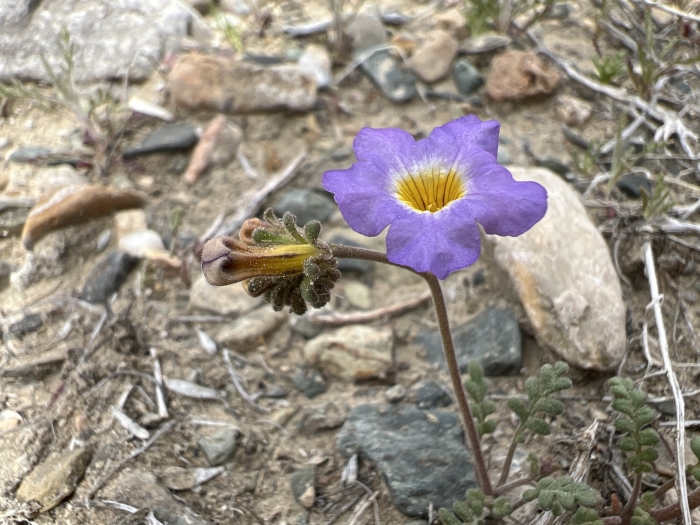Frémont’s Phacelia
(Phacelia fremontii)
Frémont’s Phacelia (Phacelia fremontii)
/
/

Steve Matson
CC BY 4.0
Image By:
Steve Matson
Recorded By:
Copyright:
CC BY 4.0
Copyright Notice:
Photo by: Steve Matson | License Type: CC BY 4.0 | License URL: http://creativecommons.org/licenses/by/4.0/ | Rights Holder: Steve Matson | Publisher: iNaturalist | Date Created: 2023-04-07T21:47:45Z |






















Estimated Native Range
Summary
Phacelia fremontii, commonly known as Frémont’s phacelia, is an aromatic annual herb native to diverse habitats in the southwestern United States, including the Mojave Desert, San Joaquin Valley, Coast Ranges, Sierra Nevada foothills, and Baja California. It is adapted to a range of ecological conditions from desert scrub to chaparral and grasslands, often found in open, disturbed areas such as washes and slopes. Typically, this plant has a branching stem that can reach up to 12 inches in length and is covered with fine hairs. The leaves are pinnately divided and can be sticky to the touch.
Frémont’s phacelia blooms from March to May, producing clusters of blue, pink, or purple funnel-shaped flowers that are quite showy and attract a variety of pollinators, including bees and butterflies. Its preference for sandy or gravelly soils makes it suitable for xeriscaping and wildflower gardens where water conservation is a priority. It is often used in restoration projects due to its ability to colonize disturbed soils and provide early successional cover. While it is drought-tolerant, it benefits from occasional watering during prolonged dry spells. Full sun to partial shade is ideal for this species, and it thrives in well-drained soils.CC BY-SA 4.0
Frémont’s phacelia blooms from March to May, producing clusters of blue, pink, or purple funnel-shaped flowers that are quite showy and attract a variety of pollinators, including bees and butterflies. Its preference for sandy or gravelly soils makes it suitable for xeriscaping and wildflower gardens where water conservation is a priority. It is often used in restoration projects due to its ability to colonize disturbed soils and provide early successional cover. While it is drought-tolerant, it benefits from occasional watering during prolonged dry spells. Full sun to partial shade is ideal for this species, and it thrives in well-drained soils.CC BY-SA 4.0
Plant Description
- Plant Type:
- Height: 0.25-1 feet
- Width: 0.3-1.25 feet
- Growth Rate: Rapid
- Flower Color: Blue, Purple
- Flowering Season: Spring, Summer
- Leaf Retention: Deciduous
Growth Requirements
- Sun: Full Sun, Part Shade
- Water: Low
- Drainage: Medium
Common Uses
Bee Garden, Butterfly Garden, Drought Tolerant, Low Maintenance
Natural Habitat
Native to desert scrub, chaparral, grasslands, and open, disturbed areas
Other Names
Common Names: Fremont’s Scorpion-Weed , Desert Bluebells
Scientific Names: Phacelia fremontii , Phacelia brannani , Phacelia hallii
GBIF Accepted Name: